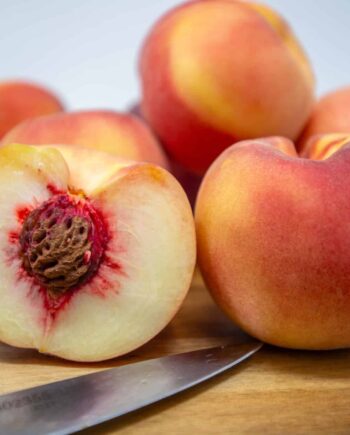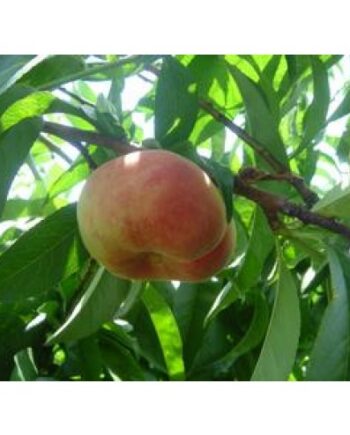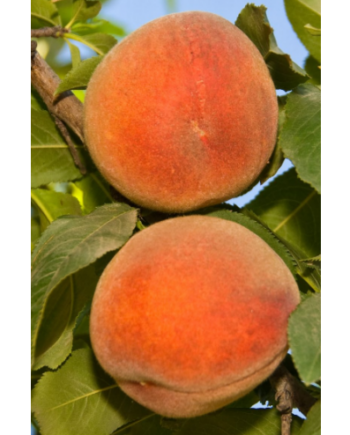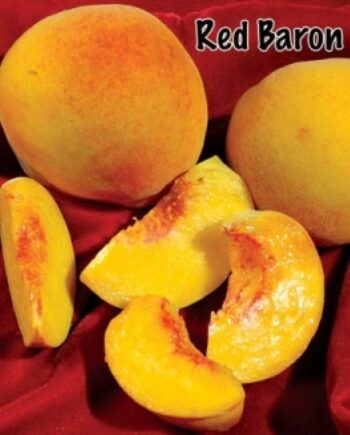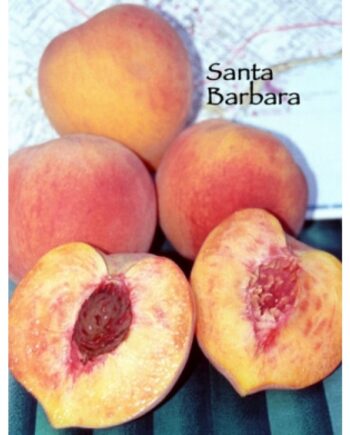Peach Trees
Showing all 6 results
-
Babcock Peach Tree
Prunus persica 'babcock' Popular white flesh peach tree, great for mild winter climates like Los Angeles. Sweet and juicy fruits are very delicious. Fragrant and heavy producer. Beautiful pink color Spring Blossoms, and Summer fruit harvests. Low ...Select options This product has multiple variants. The options may be chosen on the product page -
Bonita Peach Tree
The Bonita Peach tree produces delicious yellow freestone fruit. The skin is yellow in color with a red blush. The flesh is also yellow with red near the pit. A sweet and very tasty, subacid, and very juicy yellow peach. A...Select options This product has multiple variants. The options may be chosen on the product page -
Donut Peach Tree (Hulu Anjiri – هلو انجیری)
The Donut Peach tree produces unique, flat, saucer-shaped fruit. It is very sweet, juicy, and delicious with white flesh. The skin is light yellow with a red blush. The center is sunken with a small "stone" pit. The tree p...Select options This product has multiple variants. The options may be chosen on the product page -
Long Beach Peach Tree
The Long Beach peach tree produces yellow flesh peach for mild Winter climates that are sweet, juicy, and delicious. Red over yellow skin, freestone with firm flesh. Ripens late May to early June. 200 hours. Self-fruitful....Select options This product has multiple variants. The options may be chosen on the product page -
Red Baron Peach Tree
Select options This product has multiple variants. The options may be chosen on the product page -
Santa Barbara Peach Tree
Prunus persica 'santa barbara' Very popular yellow freestone peach from Southern California. Amazingly sweet and juicy with a nice firm texture, it's best described as delicious. It is best when eaten fresh, and this self-fruitful variety only need less...Select options This product has multiple variants. The options may be chosen on the product page
Peach Trees For Sale
Peach trees are deciduous is the winter. Leaf out and produce Pink Spring Blossom. Peaches are ripe and ready for Summer harvest. Peaches are very popular because of the their juicy flesh that is healthy, sweet, and delicious.
Plant in the full sun and grow peach trees in your own backyard. Also, plant in well draining soils. Water newly planted trees once a week in the Spring then twice in the Summer. Reduce water in the Fall as the tree loses leaves. Little to no water is needed in the Winter. Trees grow fast. Grow tall to provide shade or prune short for easy picking. Prune in the winter while trees are dormant. Fertilize with fruit tree food. Provide a balanced fertilizer in the Spring and low nitrogen high phosphorus and potassium in the winter. Use organic fungicides such as Liquicop to prevent common fungus such as peach leaf curl.
Bring the taste of summer right to your own backyard. These fruit-bearing trees are a wonderful addition to any garden, offering not only beauty but also a bountiful harvest of delicious and juicy peaches.
Peach trees are renowned for their stunning display of blossoms in the spring, turning your garden into a picture-perfect scene. The soft pink and white petals create an enchanting atmosphere and fill the air with a sweet fragrance that is simply irresistible. As the blossoms fade, they give way to the formation of peaches, which slowly ripen under the warm sun.
The fruit itself is a true delight. Peaches are known for their juicy flesh, bursting with flavor and sweetness. Eating a freshly picked peach from your very own tree is a true indulgence. Alternatively, you can use them in a variety of culinary creations, from pies and cobblers to preserves and smoothies. The possibilities are endless!
Having your own peach tree for sale means a continuous supply of delectable fruit right at your fingertips. Imagine stepping outside into your garden and plucking a ripe, sun-ripened peach from the tree. It doesn’t get any fresher or tastier than that!
So, why wait? Take the opportunity to enhance your garden and bring the joy of fresh peaches to your home. Purchase a peach tree for sale and enjoy the beauty, fragrance, and bounty it will bring to your outdoor space.
Plant Care Information
How To Water - Frequency and Duration to Irrigate
Irrigation Water Quantity and frequency based on tree maturity – Fully saturate the soil with water once per week during the early spring. Increase to twice per week as the weather warms. Water 3 times per week or more during hot summers. Provide about 5 gallons of water for a 5 gallons size plant, 15 gallons of water for a #15 size container plant, and 25 gallons for a #25 depending on soil type. Sandy soils can hold less water required more frequently, while clay soils can hold more water and require less frequent irrigation. Young trees with less developed roots require water more frequently while mature plants with developed roots will require less frequent watering.
Fertilizer and Plant Nutrition
Fertilize your tree every 3-4 months. Use a complete balance fertilizer with a 1-1-1 or 2-1-1 NPK ratio during the Spring and Summer growing season, and a formula with more phosphorus and potassium before the tree flowers to improve fruit production and development.
Winter Pruning and Summer Thinning
Prune your tree to allow light into its center for proper growth and fruit production.
Prune fruit trees in the Winter to maintain size and shape to prepare for Spring growth. Thin the tree in the Summer, and remove excessive fruits. Remove any dry twigs and branches. Cut off any new growth below the graft or very low in the tree, this will direct the plant’s energy to its main branches. Thin your trees during the Spring and Summer seasons to ensure the plant’s energy is directed as desired. Harvest ripe fruit to prevent undesired pests.
Harvesting and Pest Management
The basics of integrated pest management is cleanliness and the use of a combination of methods. This means we use an organic pesticide when the pest population reaches a threshold that requires action. Horticultural oils such as Neem oil is an organic pesticide that controls tiny, soft bodied insects. Use organic Bordeaux and Liqui-cop to manage fungus causing diseases such as powdery mildew, rust, and leaf-curls.
Keep a clean environment, free of weeds and dropped fruit that host insects or attract animals. Harvest when fruit reaches size and store indoors. Use repellants and bird netting to protect your harvest from other animals.
Sun Exposure: Full Sun
Deciduous trees need about 5 hours of direct sunlight for proper growth and fruit production.
Sunlight Sensitive plants like Cherries, Persimmons, and Plums can burn in hot climates if they lack water. Use afternoon shade to prevent this damage. A lack of light will stunt growth; balance is key.


